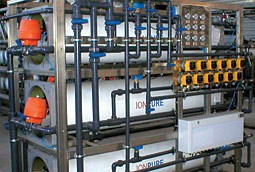
Electro-deionizationElectro-deionization (EDI) is used as an alternative for mixed bed filters. It removes dissolved salts without chemical regeneration at low energy consumption. It provides water quality of 16-18 MOhm. Electro-deionization combines two methods: electrodialysis and ion-exchange with ion-exchange resins. "HydroTech Engineering" Co Ltd has the status of Master Service Provider, acquired from Ionpure/Siemens Company, a leading equipment manufacturer of electro-deionization technologies. Nine engineers are certified in this technology and retain the right of training and servicing of this equipment. The Process Description RO permeate is divided in two flows before the EDI module. EDI feed water moves through the desalination chamber, which is filled with ion-exchange resin. Due to the electric field, ions move to the anode through the resin layer. They move through the anion permeable membrane to the concentrate flow. Cations move through the resin layer in the cathode direction; they pass through the cation permeable membrane to the concentrate flow. Ions and concentrate flow leave the module. Electrolyte flow removes ions and gases that appear on the electrodes; they leave the module. Because of the electric voltage, there is water decomposition in the resin layer. Н+ and ОН- ions implement regeneration of the ion-exchange resins. It provides a continuous operation without stopping for regeneration.
Advantages Advantages of Electro-deionization in comparison with ion-exchange filters which need regeneration:
|



